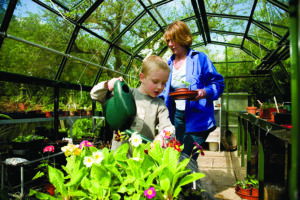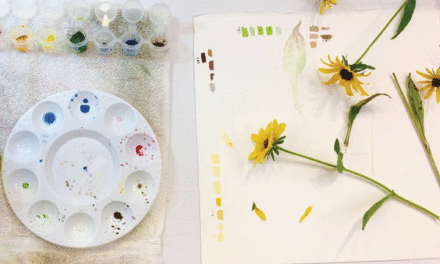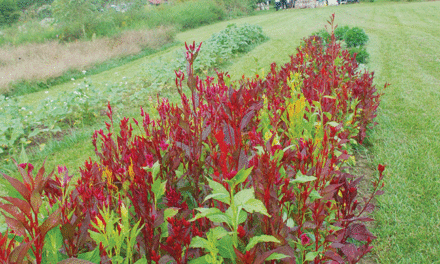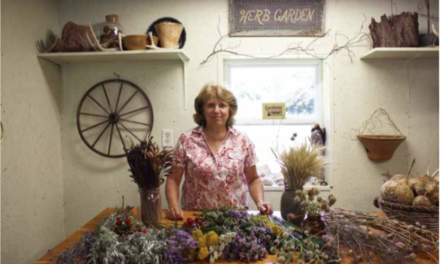
Gardening ideas can keep young people entertained and instill a love of growing plants that could last a lifetime. (Photo courtesy Hartley Botanical)
You may be sharing the load when it comes to looking after young grandchildren this summer, and with up to three months to fill with attention-occupying activities, gardening ideas can keep them entertained and instill a love of growing plants that could last a lifetime.
There’s been a lot of science over the past few years claiming to show how houseplants benefit health and well-being. Caring for a plant can lead, among other pluses, to a reduction in stress and improved cognitive awareness. Nurturing another living thing also boosts a sense of self-esteem, especially in children, and is a way to connect with nature where other opportunities are in short supply.
Hartley Botanical, which has manufactured glasshouses and greenhouses for 75 years, shared several tips and ideas for exposing children to the planted world around them.
The key to gardening with children is to show them how to do it, then let them do it. Keep your explanations as simple as possible.
The grown-up gardener is there for information and guidance, but when that first tomato appears on the family dinner table, the child should be able to brag that they grew it. And you, as the guide grew a new gardener!
Involve everyone in the planning stages—and listen to what children want. Simple projects can include planting large seeds and periodically checking on their growth.
Share space in your greenhouse or garden for children’s creativity. Starting a little area of their own can feel very special for children. And as they come back and care for their plants, they will have a goal to work towards and learn about what plants need.
If your garden overflows with an abundance of vegetables during the summer months, having grandchildren help you harvest will show them how their work and care pays off and learn first-hand where their food comes from. Peppers, squash, tomato and eggplant can all be heavy with fruit and make for a good lesson in when they are ripe and how to pick them.
To help bring the harvest alive, ask them to weigh or measure the vegetables that have grown. Ask what differences they notice when they cut a pepper open compared to a tomato?
Use the harvest to inspire them to draw, paint or create other art connected to the garden. With watering being on the to-do list both at the start and end of your day, now is a good opportunity to involve your grandchildren and talk about its value. It can help children learn that water is limited rather than something which just flows automatically from the tap.
The plants you choose to grow is worth thinking about in advance. Some crops bring results more quickly than others, which can help satiate children’s natural impatience although patience is an excellent life lesson imparted by the growing process,too.
Growing plants from seed brings in a personal connection;you’ve known the plants at each stage, just like your own children and grandchildren in their lives. Growing foods they like will serve to enhance their appreciation for nature.
Peanuts have an unusual habit that make them especially interesting to children. As the flowers fade, their stems elongate and arch over, pushing their seed-pods into the soil where they swell and ripen. If you grow them in a glass container, like a fish tank, you can see the roots and ripening seeds in the soil. Keep them warm and moist and water with warm water.
Basil is a fast-growing herb that grows very well in pots in a sunny but sheltered spot. Basil has become enormously popular for adding to pizzas and pesto and is a great way for your grandchildren to consume the herb they had a hand at growing.
French beans will germinate quickly in a summer garden spot, and starting seeds in a greenhouse or you will get a late crop in early September. It will take 7-10 days for the seedlings to emerge.
Small hands can break off the side shoots of seedlings where the leaves join the main stem with their finger and thumb so the tomato plant grows straight and tall. Put the side shoots in a glass of water and watch the roots grow. Plant them in pots and you will get a small harvest before autumn.
Go into the Greenhouse and tap the open flowers, to help the bees make tomatoes.
Outside of the typical gardening tasks, fun ideas include creating a garden journal and organizing a scavenger hunt.
Let your grandchildren pick out a notebook to record what they do in the garden each time they visit. Encourage them to draw pictures of the plants as they are growing in order to track their growth.
Some examples of things they can search for in a scavenger hunt include a flower bud, leaves longer than their fingers, a plant the color of their shirts and more. Snap photos along the way and add them to their garden journal to extend the learning once you’re back inside.






